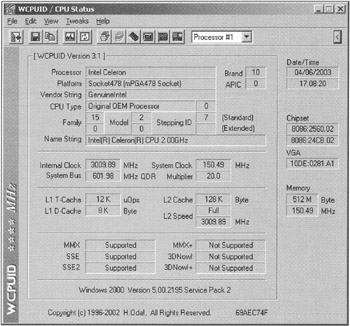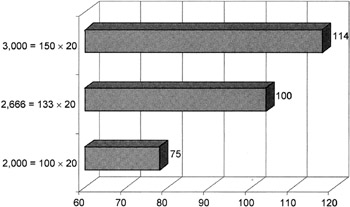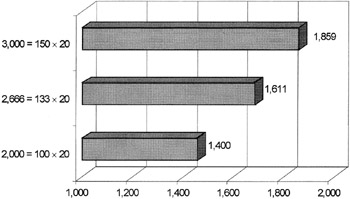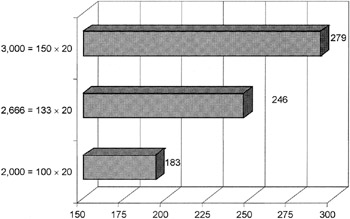Overclocking Computers with Intel Celeron (Northwood )
|
| < Day Day Up > |
|
Intel Celeron processors based on the Northwood core are manufactured according to 0.13-micrometer technology. They have a smaller amount of L2 cache memory than Pentium 4 processors based on the same core. These processors have significant technological reserve and, consequently, high overclocking potential. Testing has shown that most models can be overclocked to frequencies exceeding the nominal 50%.
Computer with Celeron 2.0 GHz
System Configuration
-
Processor — Intel Celeron 2.0 GHz (Northwood core, 128 KB L2 cache, processor core frequency operation, recommended processor-bus frequency of 100 MHz, data-bus frequency of 400 MHz, 1.55 V core supply, Socket 478)
-
Motherboard — Abit IT7-MAX2 v.2.0 (Intel 845EB chipset)
-
Hard disk — IBM 180GXP (120 GB, 2 MB cache memory, Ultra DMA/100)
-
RAM — 512 MB, DDR266, Kingston
-
Video adapter — Abit GeForce4 Ti4200, OTES, 64 MB video memory, AGP 4x
-
CD-ROM drive — Asus CD-S400/A (40x)
-
Operating system — Windows XP, Service Pack 1
Establishing Overclocking Modes
The overclocking mode was set in BIOS Setup using the SoftMenu III technology. The processor-bus frequency was increased 50% to 150 MHz. The data-transfer rate via the processor bus reached 600 MHz (4 × 150 MHz). The processor frequency was increased from 2 GHz to 3 GHz (Fig. 18.49). No steps for additional cooling of the processor were taken. An additional fan was installed in the system unit case, which blew out the hot air. Because DDR266 memory was used in this configuration, to ensure stable operation at 150 MHz, it was necessary to increase the voltage supplied to the memory 0.5 V.

Figure 18.49: Parameters for Celeron 2.0 GHz (WCPUID)
Testing the System
As tests, the following software were used: CPUmark 99, 3DMark2001 SE Pro, SiSoftware Sandra 2003, and SYSmark 2002 Internet Content Creation (ICC). The time required to encode a music file with a duration of 14 minutes and 5 seconds into MP3 format also was found. Test results are presented in Table 18.25 and in Figs. 18.50–18.53.
| FSB frequency (MHz) | CPU frequency (MHz) | CPUmark 99 rating | 3DMark2001 SE Pro rating | SiSoftware Sandra memory bandwidth benchmark | SYSmark 2002 ICC rating | MP3 encoding (sec) |
|---|---|---|---|---|---|---|
| 100 | 2,000 = 100 × 20 | 75 | 6,966 | 1,400 | 183 | 51 |
| 133 | 2,666 = 133 × 20 | 100 | 8,893 | 1,611 | 246 | 37 |
| 150 | 3,000 = 150 × 20 | 114 | 9,656 | 1,859 | 279 | 33 |
When operating in a nominal mode, the processor temperature was 48°C (188°F). After overclocking the processor to 3 GHz, the temperature reached 56C (133°F).

Figure 18.50: Celeron 2.0 GHz test results (CPUmark 99)

Figure 18.51: Celeron 2.0 GHz test results (3DMark2001 SE Pro)

Figure 18.52: Celeron 2.0 GHz test results (SiSoftware Sandra memory bandwidth benchmark)

Figure 18.53: Celeron 2.0 GHz test results (SYSmark 2002 ICC)
|
| < Day Day Up > |
|
EAN: 2147483647
Pages: 111